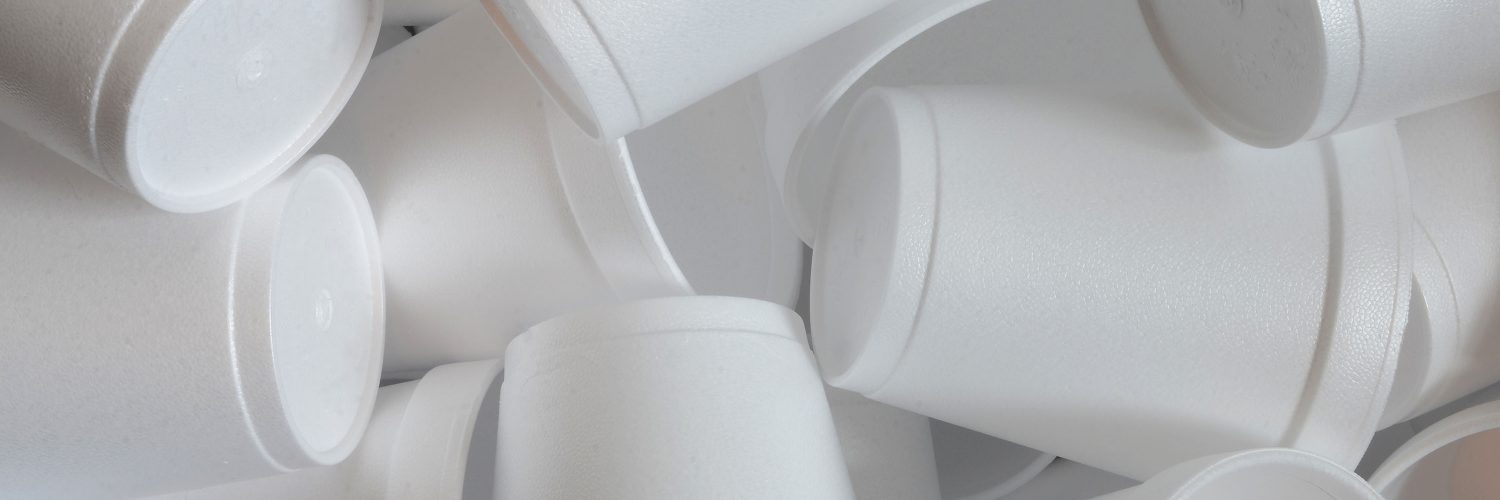Polystyrene/Styrofoam Guide

Background
What is polystyrene?
Even if you don’t know it, you’ve heard of Polystyrene before. Known to most as Styrofoam, the Dow Chemical Company’s patented name, this product can be found in packaging “peanuts”, cafeteria food and fruit trays, egg cartons, cups and the list goes on and on. Polystyrene is technically a plastic polymer that is useful in industry because of its ability to act as a solid, be melted down, reshaped and then cooled making it a solid again. This makes a plastic that’s easily molded and fitted with great versatility. Currently, there is little infrastructure in place to recycle the large amounts of polystyrene created annually; however, in Georgia Athens-Clarke County Recycling Division, Live Thrive Atlanta’s CHaRM (Center for Hard to Recycle Materials) and Chatham County (Savannah) have foam densifiers and accept polystyrene for recycling.
Science
Does Polystyrene cause a Negative Impact on the Environment?
The answer depends on several factors and should be considered relative to the level of technology utilized during production as well as that of the landfill in which it ends up. According to a production research study initiated by Franklin Associates (33 year-old life cycle analysis and solid waste management firm), polystyrene’s production can be less harmful to the environment than paper production. For paper, it takes 33 grams (g) of wood, 4g’s of fuel (oil or gas), and 1.8g of non-recycled chemicals to make a single 10.1g cup. Polystyrene uses 1/6th of all the total production elements of paper cups and only 3% of the chemical ingredients. While in production polystyrene wins points for being a positive impact in comparison to paper, recycling these products is different. It is estimated that only 1% of landfills are comprised of polystyrene weight but this doesn’t necessarily mean there isn’t a significant amount in landfills, just that the product is extremely light-weight comparatively. While the industry average for recycling expanded polystyrene or EPS (think: blocks of packaging) is around 30% and 50% for mail-order services, overall, according to the Centre for Synthesis and Chemical Biology, 99% of polystyrene ends up in landfills or dumps. Because of the strength and chemical makeup of polystyrene it takes thousands of years to decompose and when it does it could potentially release harmful toxins or carcinogens into the environment. But the infrastructure for recycling polystyrene is improving somewhat as the Alliance of Foam Packaging Recyclers continues to expand its mail-back recycling program to make it more cost-effective to return EPS for recycling. Individuals, companies and organizations, such as hospitals, pharmaceutical companies, schools and colleges, use the program to recycle EPS packaging.
Related Information
- Cereplast Inc. has been a leader in innovating biodegradable and bio based renewable plastics which can act as a substitute to polystyrene plastic. www.cereplast.com
- Other resources to explore alternatives:
http://www.genpak.com/harvest/
http://www.natureworksllc.com/
http://letsgogreen.biz/ - Foam cups are not recommended-try using ceramic cups or compostable paper if the infrastructure exists for composting those.
NOTE: The issue with “compostables” is that they need to be processed in viable municipal composting facilities that are permitted to take these materials for composting in order to facilitate speedy decomposition, and with temperatures high enough to kill pathogens. They do not break down effectively or efficiently in backyard compost piles or bins. The infrastructure for those types of facilities in metro areas is scarce due to zoning, permitting and NIMBY (“not in my backyard”) issues; that infrastructure is in the formative stages, and growing in less urban areas of Georgia. - Expanded polystyrene (Like blocks used for packing) is not that recyclable from a post-consumer standpoint because of the cost and storage time to gather a truckload quantity. Sometimes the impact of driving them to a location to recycle them negates the environmental advantage of recycling them. There are companies that collect that grade, but are mostly industrial and pre-consumer.
Recycling Resources
- https://www.recyclefoam.org, Foam Recycling Coalition’s information on how to recycle Styrofoam
- http://www.epspackaging.org/, Alliance of Foam Packaging Recycles. For a nominal shipping fee you can ship your expanded polystyrene to the Alliance of Foam Packaging Recycles.
- http://www.dartcontainer.com, DART’s CARE program. Integrated, cost-effective way to collect, densify, transport, and reprocess foam products in a foodservice environment. Also, there’s a drop-off in Lithonia, GA.
- Kennesaw Plastic Services, Scott Hawley (770) 429-8832 begin_of_the_skype_highlighting (770) 429-8832 end_of_the_skype_highlighting. Accepts all grades of bottles, containers, rigid applications, food service and protective packaging.
- TKO Polymers, LLC. Stewart Levy (770) 575-5767 begin_of_the_skype_highlighting (770) 575-5767 end_of_the_skype_highlighting. Accepts all grades except post-consumer residential for bottles, containers, rigid applications, food service and protective packaging.
- http://jetpolymer.com, Jet Polymer. Accepts post-industrial and post-consumer general purpose and high impact polystyrene.
- http://www.epspackaging.org/index.php?option=com_content&view=article&id=37&Itemid=38 – The Alliance of Foam Packaging Recyclers offers locations of drop off recycling sites across the nation.
